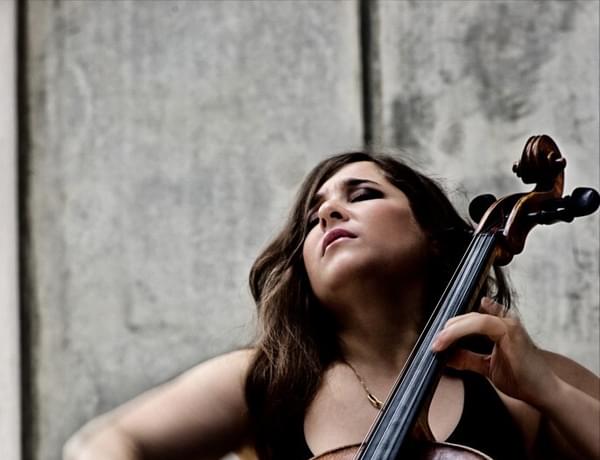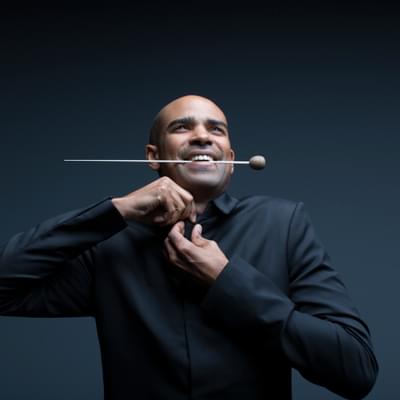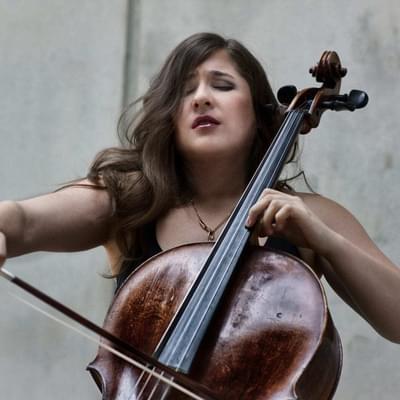Barber & Rachmaninoff

Full programme
- Dvořák, Carnival Overture (9mins)
- Barber, Cello Concerto (26mins)
- Rachmaninoff, Symphony No.3 (39mins)
Performers

Kevin John Edusei
Conductor
Alisa Weilerstein
Cello
Introduction
The scene is Boston, 1945. Already well known composer Samuel Barber, newly de-mobbed from The American Air Force, is offered a $1000 commission for a cello concerto. This would be over $17,000 today, a rate I don’t think today’s composers can even dream of!
I’ve loved this piece for years, and have dipped my toes into learning it on occasion. Technically it is really challenging, an Olympic level prowess required so I am thrilled to hear Alisa play it with us.
Barber introduces his melody themes early on, an amuse-bouche of ideas he then elaborates on as the piece develops, similar to a Brahms symphony. The second movement is a sad song, in a Sicilienne style, which features an emotional duo between cello and oboe, gradually joined by other instruments wanting to join the conversation.
The third and final part is an irregularly rhythmic dance, a tense drama where we eventually hear the sad song again but on an epic scale.
I find Rachmaninoff's Third Symphony really interesting: while he gives us the lush tunes he is so known for, it carries the orchestra into exploring more contemporary sounds and ideas.
Critics at the first performance in 1936 weren’t complimentary, probably expecting more of Rachmaninoff's romantic style but luckily for us, a few years later opinion shifted and it’s become standard repertoire, a show-case piece for the modern symphony orchestra. I love its gorgeous cello parts plus the rhythmic passages make it a very rewarding play.
And to start, Dvořák's Carnival explodes with energy and excitement. As well as putting all of us through our technical paces, watch out for virtuosic tambourine playing by our effervescent percussion section!
Helen Edgar
Tutti Cello, CBSO
Programme Notes
Soaring melodies, jangling cymbals, and cello playing to die for. Anything’s possible when guest conductor Kevin John Edusei works his magic: whether it’s Dvořák’s Czech carnival or Rachmaninoff’s soaring Third Symphony – a song of longing for a lost world, with beautiful melodies and a big-band swing. Or, most gripping of all, cello phenomenon Alisa Weilerstein throwing everything she has – and then some – at Barber’s punchy Cello Concerto.
Carnival Overture
Antonin Dvořák (1841-1904)
‘The lonely contemplative wanderer reaches the city at nightfall, where a carnival is in full swing’. So wrote Dvořák of his Carnival Overture, composed in 1891. And in ‘full swing’ it certainly is. It is one of the most boisterously good-humoured pieces in the orchestral repertoire, and not surprisingly endeared the composer to the American public when it was performed in Carnegie Hall the following year in 1892. At this US premiere the Overture formed the centrepiece of a trilogy, originally called ‘Nature, Life, Love’. ‘Nature’ was later called ‘In Nature’s Realm’ while ‘Love’, exploring more dramatic territory, became ‘Othello’. ‘Carnival,’ overflowing with human experience, was ‘Life’.
From the very start, the audience is in the position of the ‘lonely contemplative wanderer,’ plunging into the carnival, observing its ebbs, flows and sometimes secret corners. The Overture bursts vigorously out of the blocks with a prominent role for the triangle and tambourine, rattling energetically over the full orchestra. (It is somewhat reminiscent of the overture to Bizet’s Carmen in its dance-like vivacity). The Overture winds down, briefly, into a melancholy tune in a minor mode, before launching into another dance of irrepressible energy and another workout for the triangle player. Harps and bubbling clarinets introduce a sweetly romantic passage in three-time with a gently undulating refrain on the cor anglais. This is quite possibly the section Dvořák described as depicting ‘a pair of straying lovers’. They are interrupted by an unsettling, scurrying theme hinting at something more turbulent in the air. The festive music from the opening returns – in a brilliantly extended form – to round off this exuberantly coloured carnival of life.
Cello Concerto
I. Allegro moderato
II. Andante sostenuto
III. Molto allegro ed appassionato
Samuel Barber (1910-1981)
Barber was not long out of the US Air Force when the conductor Serge Koussevitzky commissioned him, on behalf of the Boston Symphony Orchestra, to write a cello concerto for the Russia emigré Raya Garbousova. (We have Koussevitzky to thank for his support of countless new works in the twentieth century, including Bartók’s Concerto for Orchestra and Britten’s Peter Grimes). In the mid-1940s Barber was steeping himself in instrumental composition, writing his second Symphony, a Serenade for strings and his Capricorn Concerto – named after his house in upstate New York not his star sign (Pisces, for anyone who’s interested). The style of the latter, a brisk, rhythmic journey through three movements, seems to influence the restless vigour of the Cello Concerto.
Asked for a programme note for this work in 1950, Barber replied that it was ‘the wishes of the composer that no analysis be printed’, preferring that the music spoke for itself. This is a slight dilemma for those of us in the business of writing programme notes, but at the risk of upsetting Barber it is perhaps useful to have some navigational aid for this eclectic, unusual piece. The first movement is fast-moving and mercurial. It opens with an abrupt downward figure, followed by a dotted rhythm first heard on the flute and cor anglais and which has an air of American folksong about it. A more lyrical theme emerges next. These three themes dominate, along with several others which move in and out of focus throughout the movement. The cello enters with one of them: a slithery slide over triplets and semiquavers, which it extends into a solo passage as the ensemble fades away. There is an electric, improvisatory atmosphere to this movement, as if someone is turning the dial on a radio to find a station, with the cellist riffing on what it hears. Some bluesy muted trumpets herald the soloist’s cadenza – an extended, virtuosic passage exploring the material further – and the movement ends with an decisive restatement of the opening figure.
The second movement is more unified and mainly features a wistful, dance-like, ‘Siciliana’ melody. At the start the cello engages in a soulful duet with the oboe, but as the music increases in intensity the movement begins to resemble Barber’s famous Adagio for Strings (1936). The mood darkens considerably towards the end, concluding in the depths of the horns and low strings. This ending sets the mood for the melodramatic start of the finale, and some edgy, jittery writing for cello (perhaps this movement above all gives the Concerto its reputation for being fiendishly difficult). After this forceful opening, the cello and low instruments embark on a solemn march over a repeated bass line (or ‘passacaglia’). Amidst the general swirl of agitation there are some curiously eerie sections, as well as experimental-sounding instrumental effects. A passage of great tension is eventually dispelled by a solo turn from the cello. By the end soloist and orchestra find some resolution – after their stormy journey together – on a blast of ‘A’ and a valedictory timpani roll.
Symphony No.3
I. Lento - Piu vivo
II. Adagio ma non troppo - Allegro vivace
III. Allegro
Sergei Rachmaninoff (1873-1943)
Rachmaninoff’s Symphony No.3 was composed in 1936, one of only a handful of original works (including the famous ‘Paganini’ variations) written in the last twenty-six years of his life. This dearth was not due to lack of inspiration, but of time: Rachmaninoff was so much in demand as a conductor and concert pianist that composing nearly always took a back seat.
It had also been almost thirty years since his previous Symphony, the mighty No.2 which holds the accolade of being the longest Russian Symphony in the pre-Soviet era (lasting around an hour). While less of – as Herbert Glass puts it – an ‘emotional steambath’ than No.2, No.3 shares with its predecessor a roster of gorgeous themes and perhaps exceeds it in terms of its subtle, nuanced deployment of the orchestra. Yet it was, for the main part, poorly received at its premiere. Fans of the ‘steambath’ style, such as critic Nikolai Medtner, found it jarringly ‘modern’ while others found Rachmaninoff’s imagination to be ‘sterile’, even ‘empty’. The composer was baffled and hurt believing it be a strong work; listeners today would most likely be similarly surprised.
There is enough even in the first movement to satisfy those who like their Rachmaninoff lush and tuneful, particularly the two main themes of the opening movement, and a sumptuous, climbing melody for strings in the second. It is hard to work out what Medtner objected to; maybe it is that the structure is tighter in this Symphony and a little less inclined to indulge its melodies for too long. While on the whole maintaining a grandly Romantic approach to symphonic music Rachmaninoff seems to be flirting with the more restless technique of some of the younger composers, such as Stravinsky, or Barber.
He moves more swiftly through his musical moods than in previous works, sometimes juxtaposing them abruptly. There are some uncharacteristic touches, including the slow movement’s segue into a light, scurrying Scherzo halfway through, completely upending the Romantic style.
The first movement has passages of dark intensity, almost ferocity, throwing the more lyrical sections into interesting shade. The finale, beginning with an assertive blast, alternates full orchestra with delicate, chamber-like groupings, the composer again appearing to observe his own Romanticism from an ironic distance. However, the final few minutes comprise a skilfully-handled build from small to vast, ending in a gloriously festive spirit – rivalling even Dvořák’s Carnival.
© Lucy Walker
Featured image © Decca Harald Hoffmann